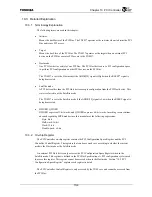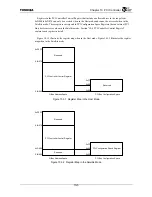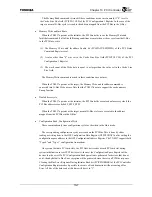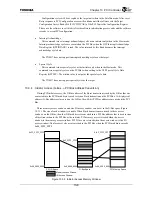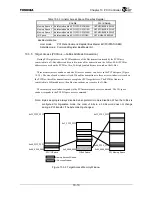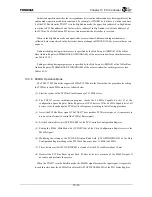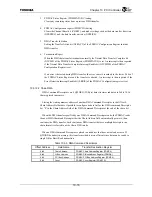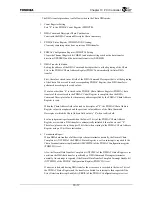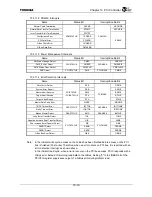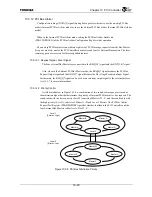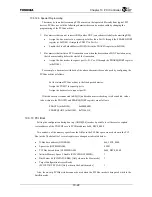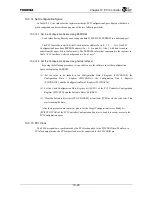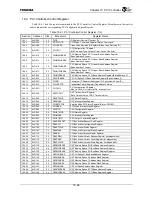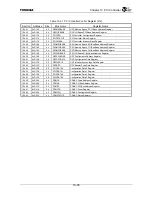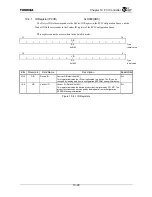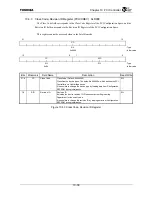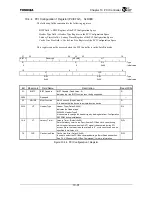
Chapter 10 PCI Controller
10-18
10.3.10.3 Dynamic Chain Operation
It is possible to dynamically add other DMA Command Descriptor Chains to a DMA Command
Descriptor Chain that is currently being processed when executing DMA data transfer. This is
done according to the following procedure.
1. DMA Command Descriptor Chain Construction
Constructs a DMA Command Descriptor Chain in memory.
2. Addition of DMA Command Descriptor Chains
Substitutes the address of the command descriptor that is at the beginning of the descriptor
chain to be added into the Descriptor Chain Address field at the end of the DMA Command
Descriptor Chain that is currently performing DMA transfer.
3. Chain Enable bit checking
Reads the value of the Chain Enable bit (CHNEN) in the PDMAC Configuration Register
(PDMCFG). If the read value is “0”, then the Chain Address field value of the DMA
Command Descriptor indicated by the address stored in the PDMAC Chain Address Register
(PDMCA) is written to the PDMAC Chain Address Register (PDMCA)
10.3.10.4 Data Transfer Size
The Transfer Size field (PDMCFG.XFERSIZE) of the PDMAC Configuration Register specifies
the transfer size of each G-Bus transaction in a DMA transfer. The transfer size can be selected
from one of the following: 1 DWORD, 1 QWORD, or 4 QWORD (Burst transfer).
1 QWORD or 4 QWORD can only be selected as the transfer size when the setting of the
PDMAC G-Bus Address Register (PDMGA) and the PDMAC PCI Bus Address Register
(PDMPA) is a 64-bit address boundary and the PDMAC Count Register (PDMCTR) setting is an
8-byte multiple. 1 DWORD must be selected as the transfer size in all other cases.
10.3.11 Error Detection, Interrupt Reporting
The PCI Controller reports the four following types of interrupts to the Interrupt Controller (IRC).
•
Normal Operation Interrupt
(Interrupt Number: 16, PCIC)
•
PDMAC Interrupt
(Interrupt Number: 15, PDMAC)
•
Power Management Interrupt
(Interrupt Number: 23, PCIPME)
•
Error Detection Interrupt
(Interrupt Number: 22, PCIERR)
When each cause is detected, an interrupt is reported if the corresponding Status bit is set, and the
corresponding Interrupt Enable Bit is set. The following tables list the name of each interrupt cause, the
Status bit, and the Interrupt Enable bit. Please refer to the explanation of each Status bit for more
information regarding each interrupt cause.
10.3.11.1 Normal Operation Interrupt
Name Status
Bit
Interrupt
Enable
Bit
M66EN Signal Assert Detect
P2GSTATUS
M66EN
P2GMASK
M66ENIE
Summary of Contents for TX49 TMPR4937
Page 1: ...64 Bit TX System RISC TX49 Family TMPR4937 Rev 2 0 ...
Page 4: ......
Page 13: ...Table of Contents ix TMPR4937 Revision History 1 ...
Page 14: ...Table of Contents x ...
Page 15: ...Handling Precautions ...
Page 16: ......
Page 18: ...1 Using Toshiba Semiconductors Safely 1 2 ...
Page 40: ...3 General Safety Precautions and Usage Considerations 3 18 ...
Page 42: ...4 Precautions and Usage Considerations 4 2 ...
Page 43: ...TMPR4937 2005 3 Rev 2 0 ...
Page 44: ......
Page 52: ...Chapter 1 Overview and Features 1 6 ...
Page 156: ...Chapter 7 External Bus Controller 7 56 ...
Page 491: ...Chapter 16 Removed 16 1 16 Removed ...
Page 492: ...Chapter 16 Removed 16 2 ...
Page 493: ...Chapter 17 Removed 17 1 17 Removed ...
Page 494: ...Chapter 17 Removed 17 2 ...
Page 495: ...Chapter 18 Removed 18 1 18 Removed ...
Page 496: ...Chapter 18 Removed 18 2 ...
Page 497: ...Chapter 19 Removed 19 1 19 Removed ...
Page 498: ...Chapter 19 Removed 19 2 ...
Page 506: ...Chapter 20 Extended EJTAG Interface 20 8 ...
Page 530: ...Chapter 22 Pinout and Package Information 22 10 ...
Page 542: ...Chapter 24 Parts Number when Ordering 24 2 ...

